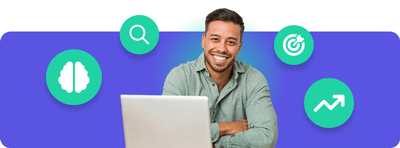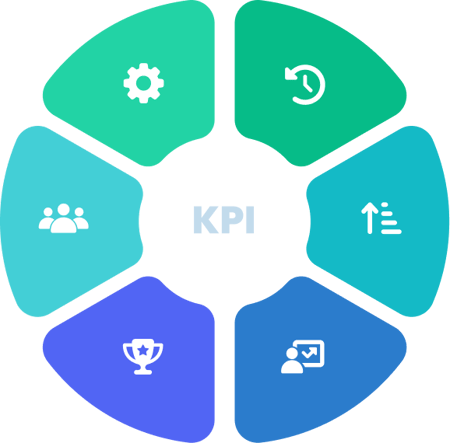Why switch to Learning in Progress?
Training is shifting from support to a business driver. Where do you stand?

Traditional learning design models no longer serve anyone
Learning and training are undergoing a shift — subtle yet transformative. If you haven’t noticed it yet, you soon will.
Traditional learning models no longer meet the needs of today’s businesses or the employees who rely on training to stay competitive. These static, one-size-fits-all approaches worked in a slower-paced world. But with markets, skills, and talent evolving rapidly, the way we design learning programs needs a complete overhaul.
In a time when businesses must fight harder for growth, metrics like course completions and hours spent learning fall short. Today, training teams have the chance to move beyond support functions and become strategic drivers of real business impact.
Three huge cultural shifts have changed the way training teams operate

70% of what employees learn is forgotten within 24 hours and 90% is lost within the first week if not applied to the job.

U.S. companies invest $200 billion annually in training, yet only 10% of that training drives tangible results according to HBR.

The skills required for a single job is increasing by 10% year over year, and over 30% of the skills needed three years ago will be irrelevant.
Learning in Progress =
The new competitive advantage
Learning and business growth go hand in hand. But sometimes the learning isn’t fast enough. Businesses don’t hit the numbers they need in order to keep up with the market; individuals don’t have the skills athey need in order to catch up with the business. And when that happens, all those static learning courses don't mean much. It's why learning is never done – it's always Learning in Progress.

Traditional learning design models represent static learning
| Learning in Progress | Static Learning |
|---|---|
| An evolved model enabling automation, course creation, and skill mapping without manual effort to stay ahead of business objectives. | Outdated programs addressing immediate needs with one-off training, focused on time spent and completion rates. |
|
Aligned with strategic objectives and business priorities
|
Training budgets viewed as expenses, not investments
|
|
Delivers targeted training based on evolving market skill demands
|
Limited to onboarding and compliance
|
|
Create valuable training as the business needs evolve leveraging AI and automation tools
|
Course creation involves repetitive, manual work over months
|
Static learning only gets you so far
Here’s why winning organizations are adapting to a Learning in Progress model:
Introducing Learning in Progress (LIP)
Learning in Progress is the operating system for modern business growth.
It’s a framework that makes learning pervasive, flexible, and performance-driven. From onboarding to leadership development, LIP helps to ensure learning happens wherever it’s needed, when it’s needed.
Anchored by the "Three Ms" — Movement, Metrics, and Mindset — LIP empowers businesses to:
- Scale learning beyond L&D to empower every team
- Drive measurable outcomes with six essential KPIs
- Shift from training as an obligation to learning as a competitive advantage

Learning happens in the moment, embedded in how teams work

Six KPIs replace vanity metrics, tying learning directly to business outcomes

A culture of curiosity and adaptability turns learning into a strategic advantage
This isn’t just about doing learning better -
it’s about making learning the backbone of your organizational agility.
Learning in Progress replaces vanity metrics with six KPIs
1. Operational efficiency
Reduce waste and maximize outcomes
2. Time-to-proficiency
Get employees job-ready faster
3. Revenue growth
Drive top-line results through skills alignment
4. Learner engagement
Motivate participation in meaningful learning
5. Retention rates
Keep top talent and boost long-term knowledge retention
6. Promotion rates
Build leadership pipelines for the future

When you measure what matters, learning stops being an expense.
See where you stand.
How much does your organization practice learning growth and velocity? Take the Learning Velocity Assessment to reveal:
- Your learning velocity score
See where your organization stands within the 3Ms framework — Movement, Metrics, and Mindset - Discover your strengths and gaps
Understand how well your current learning strategy supports velocity and measurable outcomes - Personalized recommendations
Get tips to address key gaps and accelerate your progress toward a, future-ready learning culture

Embrace Learning in Progress with CYPHER Learning
With CYPHER Learning, you can manage all your training initiatives from an easy to use platform that unifies LMS, LXP, and course development. Learning in Progress isn’t more work—it enables your team to embrace a more connected and continuous way of learning across the organization.
Deliver learning
CYPHER provides an easy to use LMS with a super short learning curve.
Deliver skills
CYPHER helps stop knowledge gaps from slipping through.
Deliver automation
CYPHER automates workflows, course creation and skills mapping so learning happens fast.
Create courses from content you have – Simplify the course creation process by automatically generating learning content from existing resources.
Automated mapping of competencies and assessments – CYPHER uses intelligent automation to map competencies and assessments, ensuring that your learning objectives align with the required skills.
Create courses in 50+ languages – Deliver content to a global audience with built-in multi-language support, eliminating language barriers.
Automate repetitive tasks – Save time and reduce human error by automating routine administrative tasks like enrollment, reminders, and notifications, allowing L&D teams to focus on strategic initiatives.
Personalized learning paths – Use automation to tailor learning experiences for individual learners based on their progress, preferences, and performance, ensuring more effective outcomes.
Smart recommendations – Automation recommends courses, learning paths, and additional resources based on learners' needs and performance.
Workflow automation – Automate key workflows such as course approvals, feedback cycles, and course completions, streamlining the entire learning management process from start to finish.